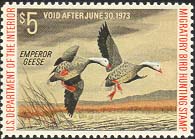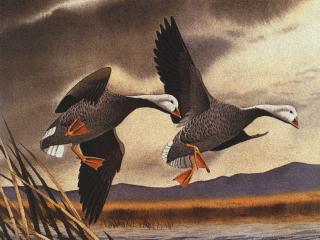

Back to RW39 Back to the Federal Index Home
A LITTLE HISTORY ON THE 39TH (1972-73) DUCK STAMP ARTIST


His parents were Arthur J. and Mary (Morgan) Cook, two students from Iowa who met while they were attending Cornell College. They were living in Oak Park, Illinois when he was born on September 15, 1931. The family moved to the Minneapolis area when Arthur was ten years old and his sister Sally was eight. There, his father took a job as a savings and loan examiner. His mother continued her work as a schoolteacher.
Following a lead in a notice on the school bulletin board, he found his first job in commercial art. He worked for Howard Lee Studios until they folded. Afterwards he took two short-term positions before obtaining a job with Campbell Studios where he stayed for eight years. After that, he took a position with Honeywell as their Industrial Art Director.
Mr. Cook met Joan Devoy of Minneapolis rather reluctantly on a blind date in 1952. The evening worked out splendidly, and from then on, neither one had to worry about any more blind dates. They were married in June of the next year. Like many newlyweds, the Cooks experienced a lack of space and time during the early years of their marriage. Because of this, Mr. Cook neglected his painting and became an avid reader of science fiction.
When the family moved to a new home, he spent much of his spare time on a new interest-gardening. It was at this time that he first gained recognition, not as a painter, but as a lily hybridizer. He did manage to combine the two interests by doing botanical drawings for the North American Lily Society yearbook. At the time, Mrs. Cook acted as wife, homemaker, and mother of four teen-aged children. She also worked and went to school.
Mr. Cook returned to his painting more and more, and by the time he won the Duck Stamp competition, he jokingly said that he took time off from his avocation of painting to go to work. Throughout his life, his favorite pastimes were hunting and fishing. Along with his sporting gear, he always carried a camera when he went, combining pleasure with research for paintings.
His other avocation was conservation. He worked with some success at coordinating the efforts of various groups to save an eagle feeding and resting area in Iowa. Some of the conservation organizations that he worked in are the National Audubon Society, Ducks Unlimited, Trout Unlimited, both the National and International Wildlife Federations, and Buzzard Council of America.
Mr. Cook died on August 6, 1993 in Minneapolis, Minnesota.
--------------------THE ART--------------------
Emperor Geese was painted in full-color watercolor. The print was by photolithography using a five-color process on white Strathmore Beau Brilliant paper. The edition of 950 prints with the first 200 remarqued is hand signed in pencil and numbered. The image size of the print is 6-3/8" x 9". There are 20 artist’s proofs and four printer’s proofs.
--------------------THE STAMP--------------------
Emperor Geese…Engraved by the Federal Bureau of Engraving from the original artwork. Printed in yellow, orange, brown, and black ink. The stamp sold for five dollars. Postal records show 2,179,628 stamps sold. First day of sale was July 1, 1972.
Most of the information contained above is from the book Federal Duck Stamp Story, Fifty Years of Excellence, by Laurence F. Jonson; Alexander & Co. It is used here with permission from the author. For more information on this book, please click here.